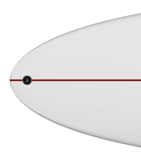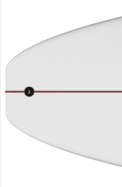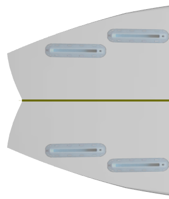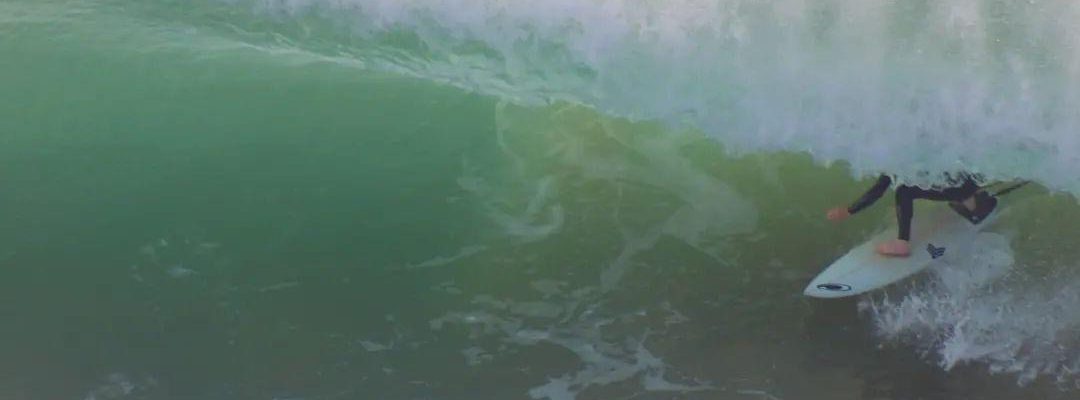SURFBOARD DESIGN FEATURES
So many variations in surfboard design effect the performance, ability and versatility of the board. The configuration of these elements results in the perfect ride. As the shaper/designer I can work with and assist you in what you are looking for, from the outline profile, rocker profile, the thickness and length. These are just some elements which when combined will effect the performance and versatility of the surfboard. It’s important to feel comfortable and confident on your board to get the most out of your session, whether it’s just for fun or for pushing your limits!
Rocker Profile
The amount of curve the bottom deck has from nose to tail and the amount of variation in that curve determines how the board will turn. A surfboard with increased rocker works best in steep powerful fast waves and has a loose characteristic. While surfboards with a low rocker work well in slow mushy waves for example longboards and fishes. Low rocker helps you catch waves with ease because of their increased volume and low entry rocker. Thinner boards can get by with less rocker because it will flex through turns which actually increases the rocker also depending on the stringer used! The apex of the rocker is generally at the widest point of the rail outline, allowing the rails to synchronize with the bottom rocker curve. A surfboard with more tail kick will often increase control but tend to slow it down due to water running off increased surface area of the board. The less curve in the tail rocker the faster the board will plane. How the nose rocker flip blends into the mid-section and then out the tail kick defines the boards behavior. The nose rocker controls how the board enters the water, if there is a flatter entry this helps create drive and speed through the rest of the board, if there is increased nose rocker this helps improve maneuverability.
The current trend of rocker designs some top surfers are using is a medium entry nose rocker blending smoothly into the mid-section and then really increasing from the fins out to the tail. This creates speed straight from the takeoff , also when you apply weight on your front foot, but then the tail kick maintains maneuverability off the back foot.
Outline Profile
The general outline shape of the surfboard directly affects how the board performs on the water and responds to each turn. The more curve in the rail outline assists with maneuverability but lacks the forward flow and drive. These style surfboards are usually ridden in powerful hollow surf where top to bottom rail surfing is required and tight arcs in the pocket can be maintained (aggressive performance surfing). The more parallel the outline with a straighter elongated template increases the speed and flow (drive) of the surfboard down the line but with a stiffer feel resulting in drawn out arcs and turns due to the increased surface area on the water, usually displaying a swallow tail or square tail. This design works well with nose rider logs, fishes and stinger style surfboards.
A well-balanced surfboard can have both features which is called a hybrid outline with a smooth curved nose outline blending into a straighter elongated mid-section flowing out into an aggressive tail shape providing speed and maneuverability.
Tail Profile
The tail provides response to the boards motion as the water exits the board around and through the fins. Different tail outlines provide different performances in different waves.
Round Tail 
The flow of water down the rail is bent around the tail and released out one point. This flow provides a smooth turning radius whilst maintaining speed, stability and hold in fast, hollow, powerful surf. The reduced surface area enables looser and tighter turns in the pocket and quicker rail to rail transition, it’s quite a versatile shape and generally suits an all-rounder surfboard.
Pin Tail 
Much like a rounded tail but with a narrower pointy template, the pin tail provides extra drive and hold down the wave face due to the extended elongated tail and speed edge. Usually suitable for big wave surfing or hollow barrel chambers. Mainly featured on semi guns or big wave guns.
Square Tail 
Carries increased surface area with a wider outline out the back which provides lift in the tail. The two back corners act as a release point for the water flowing down the rail providing stability and quicker, sharper turns on the wave face. Easy to catch waves and navigate through flat sections. Generally suited for high performance small wave surfboards, or beginner boards because of the stability.
Squash Tail 
With a wide outline blending into a blunt rounded tail, pretty much a hybrid of a square and a round tail, providing a balance of performance and stability in most wave types. The increased surface area creates the lift and stability and the blunt rounded back end maintains the performance. Also, a preferred choice for performance shortboards.
Swallow Tail 
Maintains speed and drive with the longer rail and wide tail, while the inverted v cut out at the back end provides control by allowing the tail to submerge in the water during each turn. Mostly ridden in small mushy surf (a fish is a perfect example). The swallow tail is also a feature on big wave boards for the rider wanting more drive and hold from the rail down the wave face or in the barrel.
Length, width and thickness
An increase in length corresponds with an increase in volume and buoyancy. The extra length also allows earlier entry into the wave. The longer rail line increases the drive and stability.
The thickness determines the volume of the board and effects the buoyancy or flotation on the water. Thickness is determined according to your weight and level of surfing.
The width determines the stability of the surfboard and planning area which effects the speed and control. The tail width influences how loose the surfboard will be. Generally shorter surfboards have wider tails while longer boards have a narrower tail. A wide nose outline influences the entry onto the wave with increased planning area setting the rail up with increased drive. A narrower nose will fit into the pocket curl of the wave easier which allows more radical, responsive and progressive surfing. Narrower surfboards have a faster transition from rail to rail and that results in faster responsive progressive maneuvers.
Bottom deck contours
A straight single concave generally starts just below the nose and runs down the bottom deck through the fins and fades out the back. This design channels water from the front of the board down and out through the fins maintaining loads of speed and drive. Mainly used in large clean surf. The speed this design generates makes it a popular choice. A single to double concave is mainly used on small wave surfboards with the front concave providing a good planning surface for drive, and the double concave in the rear loosens up the board by channeling a single stream of water into two separate streams running through the fins and out the tail. This design is a popular choice. A Vee bottom helps with rail-to-rail transition. The design is usually found around the tail end and helps with the control off your back foot.
